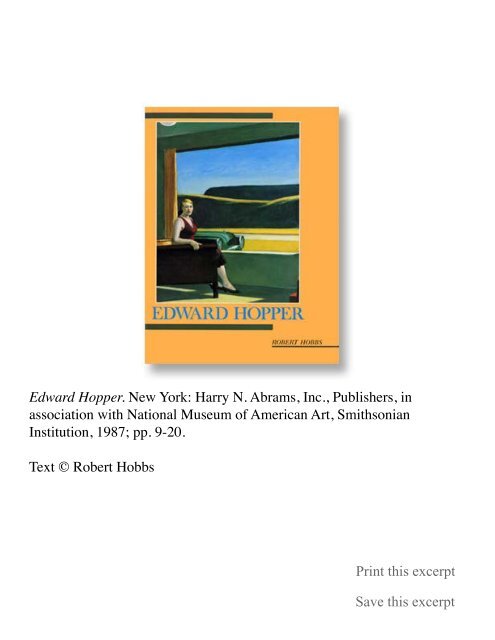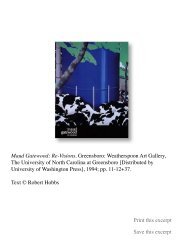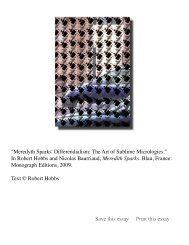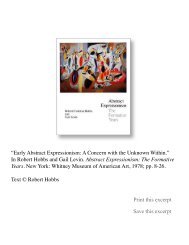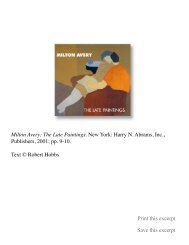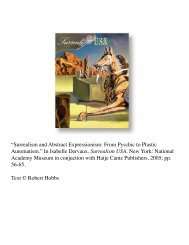Edward Hopper - Robert Hobbs
Edward Hopper - Robert Hobbs
Edward Hopper - Robert Hobbs
Create successful ePaper yourself
Turn your PDF publications into a flip-book with our unique Google optimized e-Paper software.
<strong>Edward</strong> <strong>Hopper</strong>. New York: Harry N. Abrams, Inc., Publishers, inassociation with National Museum of American Art, SmithsonianInstitution, 1987; pp. 9-20.Text © <strong>Robert</strong> <strong>Hobbs</strong>
INTRODUCTION/. Vision, A Historical ArtifactEDWARDHOPPER mined his uneventful life and found poetry in theprosaics of the modem world. After a few years of study with WilliamMerritt Chase, Kenneth Hayes Miller, and <strong>Robert</strong> Henri, followed bythree trips to Paris in the years 1906-10 and a long stint as a commercialillustrator, <strong>Hopper</strong>'s life settled into the routine of a patient observer ofchange.<strong>Hopper</strong> was born in Nyack, New York, in 1882. In 1913 he moved to3 Washington Square North, New York City, where he lived until hisdeath in 1967. In the teens and twenties he spent summers in Gloucester,Massachusetts, and Ogunquit and Monhegan Island, Maine-all favoriteretreats for vacationing artists. He married the painter Josephine VerstilleNivison in 1924; the two bought a Dodge in 1927, and over the years theymade several cross-country trips. In 1934 they built a summer house inSouth Truro, Massachusetts, on Cape Cod, where they spent six monthsout of almost every year for the rest of their lives. Even though <strong>Edward</strong><strong>Hopper</strong> began to enjoy in the mid-1920s a comfortable income from thesales of his art, the <strong>Hopper</strong>s lived frugally; they wore clothes purchased atWoolworth's and Sears, and their only extravagances were books, films,and plays.In 1924, when he was forty-two years old, <strong>Hopper</strong> was given a onepersonshow at the Frank K.M. Rehn Gallery. All the works in the RehnGallery exhibition sold, and <strong>Hopper</strong>'s art became an overnight sensationin the art world. Although success seemed to mean little to him, it permittedhim more time to paint because he could now give up his job as a commercialillustrator. Success also meant that <strong>Hopper</strong> could have his firstretrospective exhibition at The Museum of Modern Art in 1933. Nevertheless,<strong>Hopper</strong> remained distrustful of popularity throughout his life.<strong>Hopper</strong>'s remarkable following did not encourage him to step up theproduction of his art. He painted slowly; he waited for inspiration, and heusually completed only one or two paintings a year. He said that a paintingwas almost completely established in his mind before he began to paint it.His art was the result of a long and painful period of allowing various im-Office at Night1940. Oil on canvas, 22'1s x 25"Walker Art Center, MinneapolisGift of the T. B. Walker Foundation,Gilbert M. Walker Fund, 1948This painling characterizes the repressionand vulnerability of the locked-out generationthat came to maturity during theGreat Depression.9
pressions to form a synthesis, and then it was a patient and equally difficulttime of trying to re-create that synthesis, a process of finding painterlyequivalents for the vision he held. "I find, in working," <strong>Hopper</strong> wrote inThe Museum of Modern Art catalogue," ... the disturbing intrusion ofelements not part of my most interested vision, and the inevitable obliterationand replacement of this vision by the work itself as it proceeds. Thestruggle to prevent this decay is, I think, the common lot of all painters towhom the invention of arbitrary forms has lesser interest." In 1 g61 hereaffirmed this idea in a televised interview entitled "Invitation to Art"with the critic Brian O'Doherty when he mentioned that he carried in hisbillfold the following statement of Goethe:The beginning of the end of all literary activity is the reproduction of the world thatsurrounds me by means of the world that is in me. All things being grasped, related,re-created, loaded, and reconstructed in a personal form, in an original manner.<strong>Hopper</strong> added: "To me that [Goethe quotation] applies to paintingfundamentally and I know that there have been so many different opinionson painting. Now, there will be many who protest that this is outmoded,outdated, but I think it's fundamental."If the outward events of <strong>Hopper</strong>'s life-except for his almost overnightacceptance as an important painter in the mid-tgzos-are unremarkable,the inner world chronicled in his art is an intriguing story thatparallels in many respects the history of the United States in the first halfof the twentieth century. It is a story of an isolated individual dealing withthe problems of advanced industrialization: as <strong>Hopper</strong> wrote in 1927, "Itis something if a modicum of the brutal reality can be saved from the erosionof time." <strong>Hopper</strong> underscores his own interests in plumbing the ordinaryin an article on the painter Charles Burchfield. After citingEmerson's statement "In every work of genius we recognize our own rejectedthoughts," he describes Burchfield's art in a manner apposite to hisown:From what is to the mediocre artist and unseeing layman the boredom of everyday existencein a provincial community, he has extracted that quality we may call poetic,romantic, lyric, or what you will. By sympathy with the particular he has made it epicand universal. No mood has been so mean as to seem unworthy of interpretation; thelook of an asphalt road as it lies in the broiling sun at noon, cars and locomotives lyingin God-forsaken railway yards, the streaming summer rain that can fill us withsuch hopeless boredom, the blank concrete walls and steel constructions of modern indust7y,mid-summer streets with the acid green of close-cut lawns, the dusty Fordsand gilded movies-all the sweltering, tawdry life of the American small town, andI 0VISION, A HISTORICAL ARTIFACT
ehind all, the sad desolation of our suburban landscape. He derives daily stimulusfrom these, that others flee from or pass with indifference.In this article <strong>Hopper</strong> also makes reference to "our native architecturewith its hideous beauty, its fantastic roofs, pseudo-Gothic, French, Mansard,Colonial, mongrel or what not" and to "a sense of vast expanse beyondthe limits of the picture" that are also characteristic of many of hisown works. Unlike Burchfield who becomes romantic and nostalgic in hisrealistic landscapes, <strong>Hopper</strong> approaches these subjects with an understatedrigor appropriate to the twentieth century.Coming to prominence in the 1920s, in the heyday of the flappersand the first widespread use of the 1·adio and the automobile, <strong>Hopper</strong> presenteda new and poignant vision of America. Choosing not to paint thehustle and bustle or to delight in the anecdotal, he remained true to his stoic,calm self by discovering an equivalent of his inner state in the image ofAmerica that the automobile helped to produce. His paintings approachthe disinterested casual glance of the tourist; they also emphasize streets,telephone lines, signs, intersections, gas stations, tourist homes and motels,as well as the out-of-the-way roads that provide views of run-downfarms and deserted, boarded-up houses. The assumed spectator of thesescenes may well be the taciturn and shy <strong>Hopper</strong> himself, but he or she isalso one of the new inhabitants of the twentieth century who find themselvesaliens in the world and as much a mystery to themselves as the worldis a mystery to them.<strong>Hopper</strong> merits a special chapter in the history of American art. Hefollows the art-for-art's-sake attitudes of Tonalism, a refined style thatreacts to the closing of the American frontier by accommodating itself totwilit, intimate landscapes, to nostalgia, and to a refined aesthetic thatrecoils from the vulgarity of the gilded age and that questions the aspirationsof a materialistic industrialized world. <strong>Hopper</strong> also comes after theEight, a group formed in 1908 and composed mostly of illustratorsturned-paintersled by <strong>Robert</strong> Henri, who reveled in New York City streetlife, in the influx of immigrants, and in the possibilities they provided forupsetting America's recently formed class structure. Unlike his artisticforebears, <strong>Hopper</strong> is the poetic distiller of the landscape of late indus trialism.He is also the first chronicler of the views of America dictated by theautomobile, and, most important, he is the first to understand the ramificationsof the automobile, an invention that would serve to isolate peoplefrom each other and separate them from the country they hoped to escapeto on weekends. At an early date he understood the ways that theautomobile would transform America and make it psychologically as decentralizedas present-day Los Angeles. This book is about <strong>Edward</strong> Hop-VISION, A HISTORICAL ARTIFACTl l
Seawatchers1952. Oil on canvas, 30 x 40"Private colleaionEven though the season is summer or earlyautumn, <strong>Hopper</strong> makes the sunlight lookcold arul wintry. The couple's resignationseems to capture the mood of many peoplein the Uniied States who had gotten overpost-World War Il euphoria arul fourulthemselves caught up in the unresolvableconflict of the Cold War.per's vision of a changing America, a view that is now so widely acceptedthat it requires some effort to grasp the truly innovative nature of this artwhich deemed change worthy of consideration.The automobile's entry into American life permits a new outlook thatdiffers radically from the point of view of the nineteenth-century Americanitinerant landscape painters who formed the Hudson River School.The earlier view was epitomized in Thomas Cole's painting The Oxbow. Situatinghimself high on a hill in the foreground of the painting with his easel,paintbox, and palette, Cole affirms the fact that the Oxbow is apicturesque subject that merits careful scrutiny and repeated periods ofcontemplation. He places himself in the land to suggest to art observersthat they emulate his painstaking meditation on nature's wonders. Cole'sattitude was enlarged upon by his student Frederic Edwin Church, whotraveled several continents to find the quintessential vantage point. Althoughhis grand paintings usually synthesized several scenes, he encouragedthe idea that he had found a new and most profound view of nature.His descriptions of his trek to the volcano Cotopaxi in South America includea summary of the trees that were cut down to reveal the breathtakingscene that he immortalized in his art, a view never before witnessed byanother human being.The Hudson River artists' regard for nature as something grand andprofound and as a subject worthy of detailed study was overturned by theAmerican painters Theodore Robinson, who endorsed French Impressionism,and James A. McNeill Whistler, a proponent of the art-for-art'ssake approach, who wished to capture not so much a view of a specificlandscape as an image of the cursory glance that is characteristic of modemlife.<strong>Hopper</strong> transformed the sweeping glance oflate nineteenth-centurydandies who strolled along the recently formed grand boulevards of Paristo the strangely suspended gaze of motorists and moviegoers. Motoristssimply watch nature as it unfolds before them; they do not note particularflora and fauna; they are more caught up in the continuity of the land thanwith specific scenes. One scene resembles another; the outing becomes thereal adventure, and any single view is subservient to the speed of the car,the narrowness or width of the road, the weather, and the light. This unfeelinglook, which <strong>Hopper</strong> captures in many of his works, is unsettling,for it presents a scene that is memorable by virtue of its commonplace appearance.People may have strong feelings about <strong>Hopper</strong>'s art, but hedoes not give them clues that allow them to become immersed in the landscape,to view it as sublime, or to f~el that it somehow represents a purer,untrammeled world and a higher morality. Nature, in <strong>Hopper</strong>'s art, is surveyedby a disinterested twentieth-century viewer used to the continuumVISION, A HISTORICAL ARTIFACT
Second Story Sunlight19fio. Oil on canvas, 40 X 50"Whitney Museum of American An, New York City00-54In his art <strong>Hopper</strong> pla)'f!d with intimacyand distance: his people look like distinctindivid1.Ul.l.s in spite of the fact that they arerepresentative types. In Second StorySunlight <strong>Hopper</strong> contrasts youth and oldage. Both people are at a remove from lifeeven though the young girl is eager to getoff the balcony and become a part of lifewhile the woman is content to remain aspectator.that constitutes both a drive in an automobile and a film; and because it islittle understood, nature becomes in the art a mysterious force, a symbol ofthe other. <strong>Hopper</strong> is the first artist to recognize that visual images in thetwentieth century have become so common that they have also become expendable.He plays on the way individual images become prevalent in thetwentieth century, and he memorializes in his art undistinguished scenesavailable to everyone. Frequently his images pay homage to the ubiquitousvictims of progress by picturing abandoned country houses, weeds alongrailroad tracks, and desolate Victorian mansions.In his art <strong>Hopper</strong> stops the narrative that constitutes a drive in anautomobile or the montage of a movie to focus on strangely isolated stills.Seen by themselves, these stills are mysterious and haunting. They evoke adesire for the rest of the narrative, and they powerfully convey the breakupof the storyline, the disjunction that is characteristic of modern life. Inthis manner they awaken in the viewer a desire for the whole, and thuselicit feelings of isolation and loss. The feelings of loneliness experiencedby viewers of <strong>Hopper</strong>'s art, who sometimes use the term "desolation" todescribe what they see, come from the fact that a continuum has beenbroken. The machinery of industrialism is no longer operative, and the illusionof progress as a motivating life force is no longer believable. Bystripping modern life of its illusions of momentum, <strong>Hopper</strong> leaves hisviewers isolated; he shows the breakdown of traditional spiritual underpinningsin the modern world and reveals the poverty of a society that hasforsaken a meditative calm for a frenetic view of progress. The stills communicatea profound disbelief in the positive benefits to be obtained fromconstant movement. In <strong>Hopper</strong>'s stills there are never enough clues toprovide a definitive narrative; his mature paintings always emphasizetheir fragmentary state: they remain unsolvable question marks that indicatea profound distrust of the entire modern age.In a letter written in 1948 to Norman A. Geske, who was then at theWalker Art Center, <strong>Hopper</strong> described the origin of Office at Night ( 1940)and indicated an awareness of his freeze-frame technique:The picture was probably first suggested fry many rides on the 'L' train in New YorkCity after dark and glimpses of office interiors that were so fleeting as to leave freshand vivid impressions on my mind. My aim was to try to give the sense of an isolatedand lonely office interior rather high in the air, with the office furniture which has avery definite meaning for me.Later he cryptically referred to the insoluble puzzle his art representedwhen he told his friend Lloyd Goodrich, then director of the WhitneyMuseum of American Art, that Second Story Sunlight ( 1960) "is an attempt16 VISION, A HISTORICAL ARTIFACT
to paint sunlight as white, with almost or no yellow pigment in the white.Any psychologic idea will have to be supplied by the viewer." And in responseto a question by Brian O'Doherty regarding the content of his art,<strong>Hopper</strong> responded, "I can't always agree with what the critics say. Youknow, it may be true or it may not be true. It's probably how the viewerlooks at the pictures. What he sees in them .. . . That they really are."Both <strong>Edward</strong> and Jo <strong>Hopper</strong> tried to compensate for the isolationand fragmentation reflected in his art by assigning names and identities tosome of the characters in the paintings and by giving nicknames to thepaintings themselves. In the ledger books that Jo kept over the years torecordpaintings leaving the studio, Office at Night is called "ConfidentiallyYours Room 1 oos" and the woman in the work is referred to as Shirley(Vol. II). When describing Conference at Night ( 1949), J o notes that "Deborahis blond, a queen in her own right. Heavy table golden oak. Big greenledger with dull red edge. Sammy better looking than here in drawings"(Vol. III). This game of storytelling was probably initiated by Jo, who wasas garrulous as <strong>Edward</strong> was taciturn, but it is clear from the entries herethat the artist joined her in trying out roles for his figures:Sea watchers-Sheila and Adam, Irish girl,gentle, sweet, large-Yankee clam diggerveryfine people-on New England coastfor late swim. People inventions of E.H. (Vol. III)Second Story Sunlight-1960-A.M. sunlight . . .2 figures-white haired Gothic and elderly and"Toots"-"good Toots, alert but not obstreperouslamb in wolfs clothing" the painter quoted. (Vol. Ill)A Woman in the Sun-1961-E.H.called her "A wise tra:mp. "Begun cold,very early Oct. I . Tragic figure of smallwoman, blond straight brown hair, grabscigarette before shimmy skirt-brightestnote at R. seen off stage, on curtain ofwindow off stage right easts {sic].Cigarette and sad face of woman unlit.(Vol. III)Intermission painted in N.Y. Studio inMarch & April 1963. E.H. says she is"Nora." ... Nora, with strong long hands.She is not the kind to slipfeet out oflong reasonably high heeled pumps. E.says Nora is on the way of becomingan "egghead." An efficient secretary OTprize chatelaine of big house. (Vol. III)Conference at Night' 949· Oil on canvas, 27 1 / • x 40"Counesy Wichi1a An Museum. KansasThe Roland P. Murdock CollectionAfter his marriage to jo, <strong>Edward</strong> used hiswife as a rrwdelfor the worrum in his paintings,being careful to change lunface andhair to reflect a specific type. This paintingis significant for the way it characterizesthe woman as an equal to the two men.During World War II, women assumedimportant roles in business and industry,and this painting indicates a new basis formale/female interaction that was soonended after the war l7y government propagandaaimed at popularizing the traditionalfemale roles of homemaker, wife,and mother.VISION, A HISTORICAL ARTIFACT 19
It is possible to write these references off as an innocent game playedby a childless couple. But it should also be pointed out that each painting isan abstraction from life, and that many of the works created a disturbingvoid that affected even the <strong>Hopper</strong>s. One could try to make the Nora ofIntermission ( 1963) a modern-day counterpart to Ibsen's famous Nora, butthe woman in the painting could just as easily be a secretary. The lack ofspecific information about these people is essential to the art and helps toaccentuate the mystery of the common place.<strong>Hopper</strong>'s works depend on ellipses, on the missing parts of a narrative,and on the presence of a viewer who is assumed within the fictiverealm of the painting and made a reality by the actual people who look atthe work of art. These people take note of the absence of a storyline andthen face an ambiguous situation. They do not provide the narrative forthe picture so much as note the presences and absences on which this art ispremised. In <strong>Hopper</strong>'s work the assumed viewer is analogous to a camerain a film: the unseen but essential modus operandi of the work of art. Thecamera analogy is important, for it enabled <strong>Hopper</strong> to be intimate and distant,to show glimpses of people's everyday lives without seeming to invadetheir privacy. Frequently the people spied upon are types ratherthan individuals, and thus the act of looking is made abstract; it becomesmore a phenomenon of the modern world rather than an individual's voyeuristicfantasy, although at times <strong>Hopper</strong> does succumb to the latter. Hispaintings, watercolors, and prints maneuver us so that our passive lookingbecomes a means for acting out the alienation of modern life. The observerthen becomes an actor, the painting a script, and the play a reading ofthe script by the actor/viewer.Although one cannot provide a specific narrative for an individualwork, one can look at earlier pieces made in the French and American traditionsto which this artist attaches himself and see how he has reorientedthese images. He pares away elements of traditional art to establish a significantellipsis which creates a new, alienated vantage point indicative ofthe twentieth-century point of view.Intermission1963. Oil on canvas, 40 X 6o"Private collectionThe woman here appears to be both familiarand anonymous. She could be a suburbanlwusewife, a corporate executive, or amaid. <strong>Hopper</strong> is frequently concernedwith the fact that people in the modernworld can look like distinct individualswil.houi revealing any clues as to their vocationor status.20 VISION, A HISTORICAL ARTIFACT


